Derek Cai - BBC News, Singapore
Thu, September 7, 2023

Japan on Thursday successfully launched a rocket with a lunar lander at its fourth try this year, after previous attempts were foiled by bad weather.
The lander, dubbed the "moon sniper", is expected to attempt a Moon landing in February if all goes well.
Japan has twice failed to reach the lunar surface in the past year, amid setbacks for its space programme.
It is bidding to become only the fifth country to land on the Moon, after the US, Russia, China and India.
Two weeks ago, India made history when it successfully landed a spacecraft near the south pole of the Moon.
The Japanese spacecraft is projected to land within 100m (328ft) of a location near the Shioli crater, on the near side of the Moon.
It is expected to enter the Moon's orbit within four months. It will then spend a month circling the Moon before attempting a landing in February.
The $100m (£59m) mission is meant to demonstrate Tokyo's ability to land a lightweight, low-cost spacecraft on the Moon.
The rocket was also carrying the X-Ray Imaging and Spectroscopy Mission (XRISM) satellite, a joint project between the Japanese, American and European space agencies.
The satellite, containing a telescope the size of a bus, has parted ways with the lunar lander to orbit around the Earth. It will now begin studying space phenomena such as black holes.
The successful launch follows a series of failures over the past year.
Last November, JAXA lost contact with its OMOTENASHI spacecraft and aborted the Moon landing mission.
More recently in April, a private Japanese start-up, iSpace, failed to land its Hakuto-R lander after it too lost contact with the spacecraft.
Two test rocket launches have also failed this year, the latest in July when engine failure caused an explosion.
Japan launches 'moon sniper' lunar lander SLIM into space
Kantaro Komiya
Updated Thu, September 7, 2023
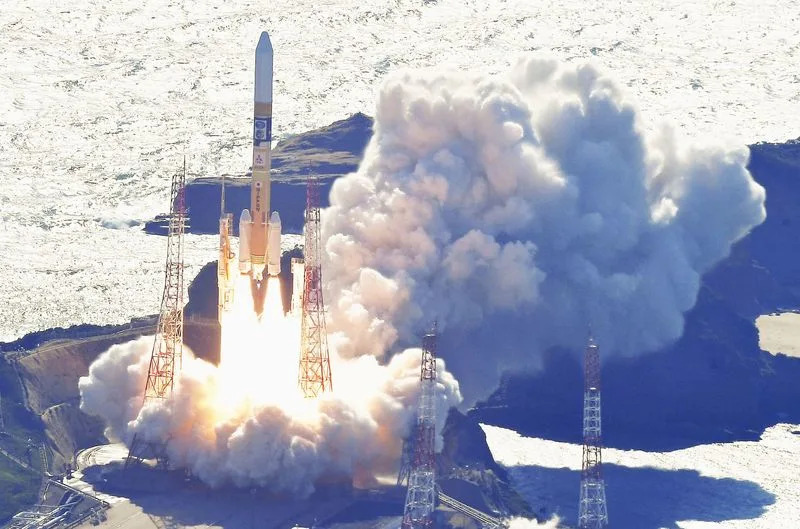
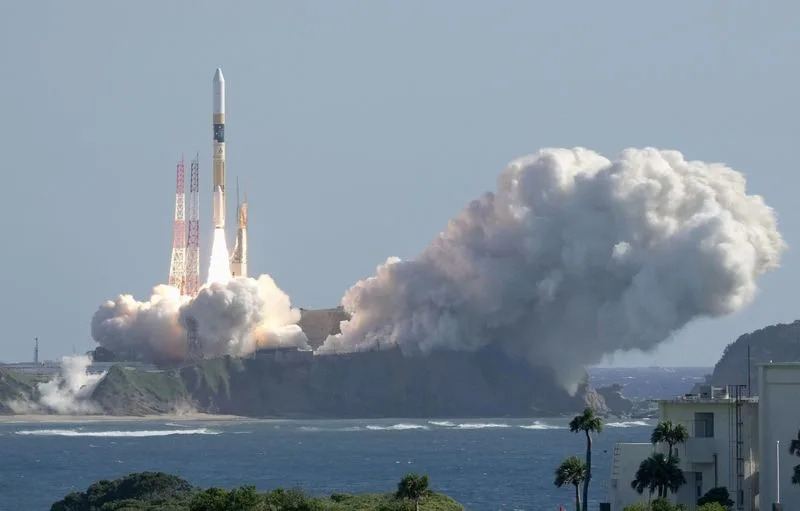
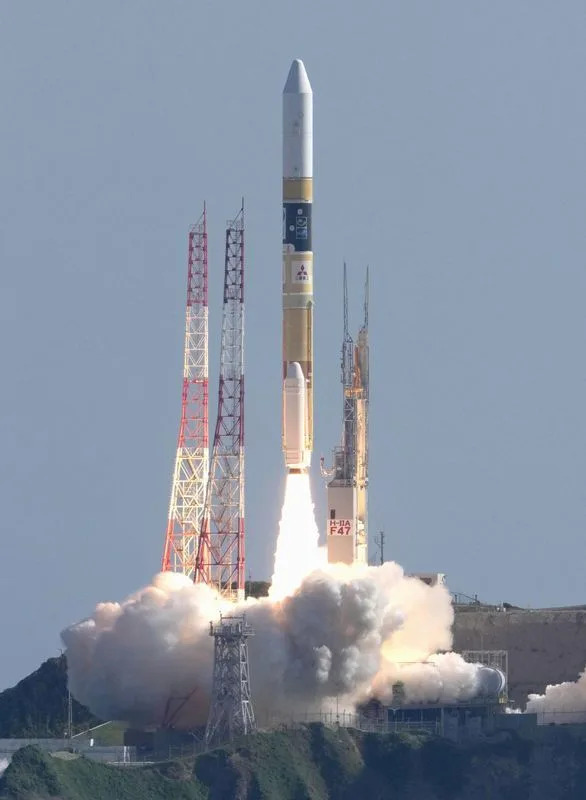
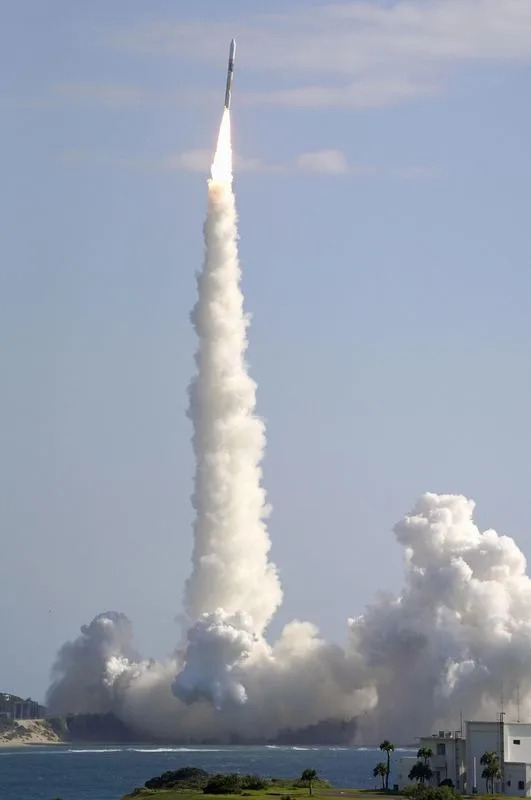
Japan launches 'moon sniper' lunar lander SLIM into spaceH-IIA rocket carrying the national space agency's moon lander is launched at Tanegashima Space Center on the southwestern island of Tanegashima
By Kantaro Komiya
TOKYO (Reuters) -Japan launched a lunar exploration spacecraft on Thursday aboard a homegrown H-IIA rocket, hoping to become the world's fifth country to land on the moon early next year.
Japan Aerospace Exploration Agency (JAXA) said the rocket took off from Tanegashima Space Center in southern Japan as planned and successfully released the Smart Lander for Investigating Moon (SLIM). Unfavourable weather led to three postponements in a week last month.
Dubbed the "moon sniper", Japan aims to land SLIM within 100 metres of its target site on the lunar surface. The $100-million mission is expected to start the landing by February after a long, fuel-efficient approach trajectory.
"The big objective of SLIM is to prove the high-accuracy landing ... to achieve 'landing where we want' on the lunar surface, rather than 'landing where we can'," JAXA President Hiroshi Yamakawa told a news conference.
Hours after launch on Thursday, JAXA said it picked up signals from SLIM showing it was operating normally.
The launch comes two weeks after India became the fourth nation to successfully land a spacecraft on the moon with its Chandrayaan-3 mission to the unexplored lunar south pole. Around the same time, Russia's Luna-25 lander crashed while approaching the moon.
Two earlier lunar landing attempts by Japan failed in the last year. JAXA lost contact with the OMOTENASHI lander and scrubbed an attempted landing in November. The Hakuto-R Mission 1 lander, made by Japanese startup ispace, crashed in April as it attempted to descend to the lunar surface.
SLIM is set to touch down on the near side of the moon close to Mare Nectaris, a lunar sea that, viewed from Earth, appears as a dark spot. Its primary goal is to test advanced optical and image processing technology.
After landing, the craft aims to analyse the composition of olivine rocks near the sites in search of clues about the origin of the moon. No lunar rover is loaded on SLIM.
Thursday's H-IIA rocket also carried the X-Ray Imaging and Spectroscopy Mission (XRISM) satellite, a joint project of JAXA, NASA and the European Space Agency. The satellite aims to observe plasma winds flowing through the universe that scientists see as key to helping understand the evolution of stars and galaxies.
Ground stations in Hawaii and Japan received signals from XRISM soon after the launch confirming that the satellite's solar panels successfully deployed, JAXA said.
Mitsubishi Heavy Industries manufactured the H-IIA rocket and operated the launch, which marked the 47th H-IIA Japan has launched since 2001, bringing the vehicle's success rate close to 98%.
JAXA had suspended the launch of H-IIA carrying SLIM for several months while it investigated the failure of its new medium-lift H3 rocket during its debut in March. Japan plans to retire the H-IIA after its 50th launch in 2024.
Japanese Prime Minister Fumio Kishida said in a social media post after the launch on Thursday that developing flagship rockets is essential to Japan's independent space activities.
"We'll build up the momentum toward the successful re-launch of the H3 rocket," Kishida posted on the social media X, previously known as Twitter.
Japan's space missions have faced other recent setbacks, with the launch failure of an Epsilon small rocket in October 2022, followed by an engine explosion during a test in July.
JAXA plans a joint Lunar Polar Exploration Mission (LUPEX) with the Indian Space Research Organisation beyond 2025, in which Japan's H3 rocket will carry India's next lunar lander into space.
The country also aims to send an astronaut to the moon's surface in the latter half of the 2020s as part of NASA's Artemis programme.
(Reporting by Kantaro Komiya; Editing by Tom Hogue and Gerry Doyle)
View comments (2)
Japan launches SLIM moon lander, XRISM X-ray telescope on space doubleheader
Mike Wall
Wed, September 6, 2023
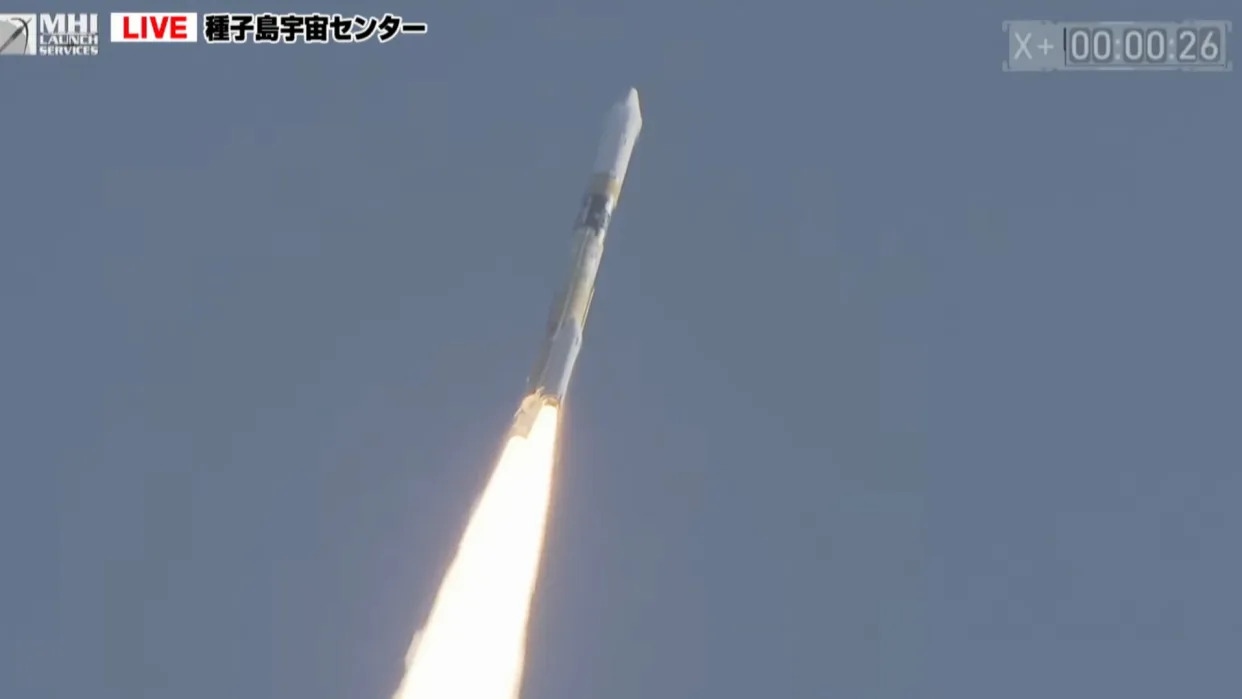
a white rocket launches into a blue sky.
Japan sent two ambitious missions soaring into the heavens today (Sept. 6) — a pioneering lunar lander and a powerful X-ray space telescope.
A Japanese H-2A rocket carrying the SLIM moon lander and the XRISM space telescope lifted off from Tanegashima Space Center today (Sept. 6) at 7:42 p.m. EDT (2342 GMT; 8:42 a.m. Japan time on Sept. 7). That was about 10 days later than originally planned, thanks to weather delays.
Both spacecraft were deployed on schedule, sequentially less than an hour after liftoff. If all goes according to plan, a few months from now, SLIM ("Smart Lander for Investigating Moon") will attempt to pull off Japan's first-ever soft lunar landing — a pinpoint touchdown that will pave the way for even more ambitious feats down the road.
SLIM "aims to achieve a lightweight probe system on a small scale and use the pinpoint landing technology necessary for future lunar probes," officials with the Japan Aerospace Exploration Agency (JAXA) wrote in a mission description.
"The project will aim to cut weight for higher-function observational equipment and to land on resource-scarce planets, with an eye towards future solar system research probes," they added.
Related: Missions to the moon: Past, present and future
Shooting for the moon
SLIM is a small spacecraft, measuring just 7.9 feet (2.4 meters) high, 8.8 feet (2.7 m) long and 5.6 feet (1.7 m) wide. At liftoff, it tipped the scales at about 1,540 pounds (700 kilograms), but roughly 70% of that weight was propellant.
SLIM will take a long, looping and fuel-efficient route to the moon, finally reaching lunar orbit three to four months from now. It will then eye the lunar surface for another month or so before attempting a touchdown inside Shioli Crater, a 1,000-foot-wide (300 m) impact feature that lies at 13 degrees south latitude, on the moon's near side.
The probe aims to land within 330 feet (100 m) of a target point within Shioli Crater — a more precise touchdown than previous lunar landers have attempted. The goal is to demonstrate pinpoint-landing tech that could open the moon, and other celestial bodies, to more extensive exploration.
"By creating the SLIM lander, humans will make a qualitative shift towards being able to land where we want and not just where it is easy to land, as had been the case before," JAXA officials wrote in the mission description. "By achieving this, it will become possible to land on planets even more resource-scarce than the moon."
SLIM also carries two miniprobes, which will be ejected onto the lunar surface following touchdown. Those two little craft will help the mission team monitor the status of the larger lander, take photos of the landing site and provide an "Independent communication system for direct communication with Earth," according to JAXA's mission press kit.
SLIM isn't the first lunar lander that JAXA has built. The agency's tiny OMOTENASHI craft was one of 10 cubesats that launched with NASA's Artemis 1 moon mission in November 2022. While Artemis 1 succeeded, OMOTENASHI did not; its handlers could not establish communications with the little probe in time for its planned touchdown try. (Several of the other Artemis 1 cubesats failed in their missions as well.)
And a Japanese lander has tried its hand at a lunar touchdown before. The Tokyo-based company ispace's Hakuto-R lander reached lunar orbit — a huge accomplishment for a private spacecraft — but crashed during its touchdown attempt this past April.
Success by SLIM would therefore be historic. Just four nations have soft-landed a probe on the moon to date — the Soviet Union, the United States, China and India. India put its name on this exclusive list just last month, when its Chandrayaan-3 mission touched down near the lunar south pole.
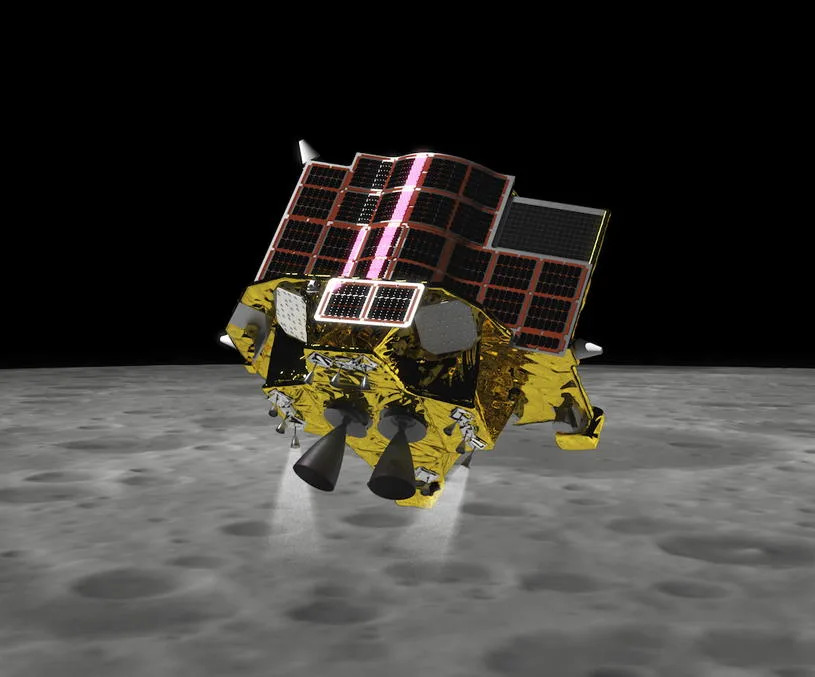
A short golden lunar lander with the grey of the lunar surface behind.
RELATED STORIES:
— Private Japanese moon lander crashed after being confused by a crater
— The moon: Everything you need to know about Earth's companion
— Chandra X-Ray Observatory: Revealing the invisible universe
An X-ray space telescope, too
As exciting as SLIM is, it's merely the secondary payload on Sunday's launch. The main spacecraft is XRISM, which is headed for a perch in low Earth orbit.
XRISM (short for "X-Ray Imaging and Spectroscopy Mission") is a collaboration involving JAXA, NASA and the European Space Agency (ESA). As its full name suggests, the telescope will study the universe in high-energy X-ray light.
"X-ray astronomy enables us to study the most energetic phenomena in the universe," Matteo Guainazzi, ESA project scientist for XRISM, said in a statement.
"It holds the key to answering important questions in modern astrophysics: how the largest structures in the universe evolve, how the matter we are ultimately composed of was distributed through the cosmos, and how galaxies are shaped by massive black holes at their centers," he added.
The observatory will focus particularly on the super-hot gas surrounding galaxy clusters.
"JAXA has designed XRISM to detect X-ray light from this gas to help astronomers measure the total mass of these systems," ESA officials wrote in the same statement. "This will reveal information about the formation and evolution of the universe."
XRISM won't be the only X-ray telescope studying the heavens from Earth orbit. Also up there right now, for example, are NASA's Chandra X-Ray Observatory and ESA's XMM-Newton, both of which launched in 1999, as well as NASA's NuSTAR, which lifted off in 2012.
Victor Tangermann
Wed, September 6, 2023
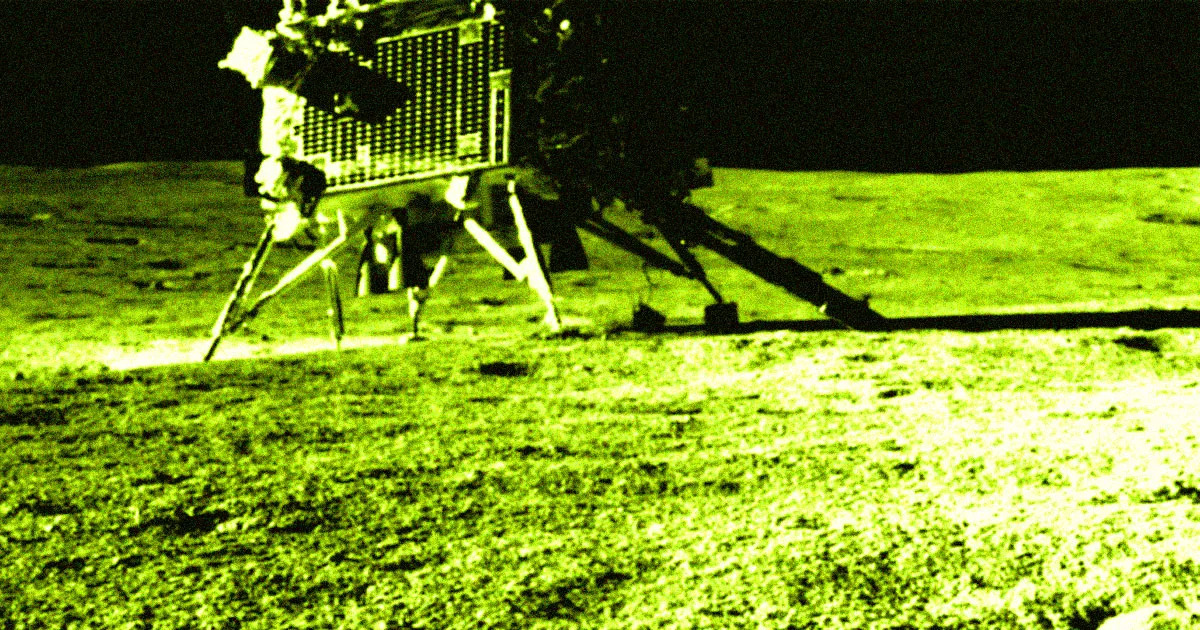
Second Landing
After safely landing on the lunar surface last month, India's Vikram Moon lander just pulled off its next daring stunt.
The lander fired up its engines, causing it to float 15 inches above the lunar surface, then moved laterally. Moments later it landed again, roughly 11 to 15 inches away from where it was sitting previously.
A clip shared by the Indian Space Research Organization shows the view from the lander as the cratered lunar surface goes up in a cloud of dust. Seconds later, the lander's view clears up again, showing a slightly altered landing spot.
"Vikram soft-landed on the Moon again!" the ISRO's update reads.
It's an impressive feat that again demonstrates India's growing off-world prowess.
"All systems performed nominally and are healthy," the ISRO wrote.
https://twitter.com/isro/status/1698570774385205621
Goodnight Moon
Shortly after landing on the lunar surface two weeks ago, Vikram released a smaller, six-wheeled rover dubbed Pragyaan, which has been exploring the surrounding area for signs of water ice since.
Vikram's successful flight was performed shortly before it and its rover cousin were scheduled to take a prolonged nap. Early Monday morning, the lander entered sleep mode.
"Vikram will fall asleep next to Pragyan once the solar power is depleted and the battery is drained," the ISRO tweeted on Monday. "Hoping for their awakening, around September 22, 2023."
The stakes are pretty high. If Vikram fails to get up from its slumber, it could be game over for the mission.
"Hoping for a successful awakening for another set of assignments!" the ISRO tweeted over the weekend. "Else, it will forever stay there as India's lunar ambassador."
Australian moon rover to hitch a ride on NASA’s giant moon rocket
Andrew Wulfeck
Wed, September 6, 2023
Australia is aiming to become one of only a handful of countries to operate a rover on the Moon and said it could reach the lunar surface by 2026.
The Australian Space Agency is working with NASA to design and launch the rover that will depend on an Artemis launch to make it to the Moon.
The agency said the first attempt could occur as soon as 2026, when NASA is expected to launch the Artemis III crew to the Moon’s surface.
"Drawing on Australia’s world-leading remote operations expertise, the rover will collect lunar soil, known as regolith. NASA will attempt to extract oxygen from the sample. This is a key step towards a sustainable human presence on the Moon," the ASA said in a statement.
SEE THE OBJECT HUMANS LEFT BEHIND ON THE MOON

Australian Space Agency moon rover
Russia recently attempted to put a spacecraft on the surface of the Moon, but the mission is believed to have ended in spectacular fashion, with a massive crater now seen from satellites near the expected landing site.
If Roscosmos, Russia’s space agency, had been successful with the Luna-25 mission, it would have been the first time since the 1970s that the country had successfully landed a spacecraft on the lunar body.
India, the Soviet Union, China and the United States are the only countries to have successfully operated a spacecraft on the Moon, with several other countries eyeing to achieve the historic feat.
SPACECRAFT CAPTURES PHOTOS OF NEW CRATER ON MOON LIKELY CREATED BY FAILED MISSION
Australia has yet to determine a name for the rover but said it is turning to its citizens for help.
The space agency has opened a website for Australians to submit potential names that will one day come to a public vote.
The winner is expected to be announced in December, and the name will be placed on the robot for the universe to see.
Original article source: Australian moon rover to hitch a ride on NASA’s giant moon rocket
No comments:
Post a Comment